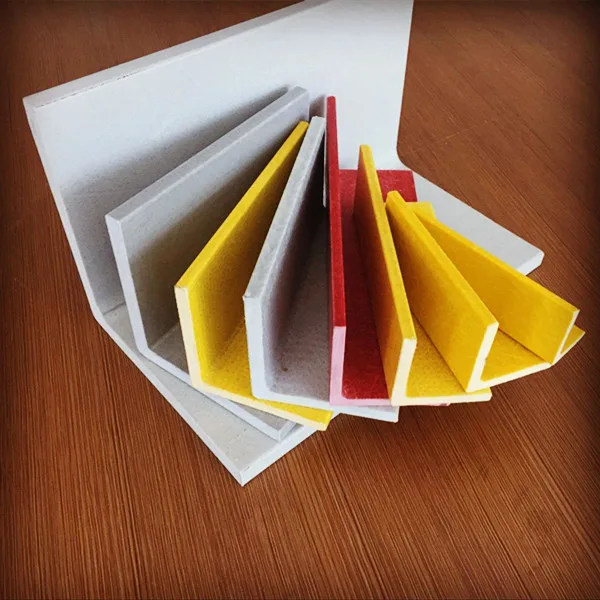Fiberglass plastic angles have revolutionized structural design with their unique combination of strength, durability, and versatility. While their benefits are well-known among engineers and manufacturers, their diverse applications might surprise even the most seasoned professionals. Let’s explore how these innovative materials are being used across industries and why they’re gaining popularity worldwide.

fiberglass plastic angle
Understanding Fiberglass Plastic Angles
Fiberglass plastic angles are structural components made from fiberglass-reinforced plastic (FRP). Designed to provide strength and support, these angles are lightweight, corrosion-resistant, and capable of withstanding extreme conditions. Their unique properties make them ideal for applications where traditional materials like steel or aluminum might fail.
Key features include:
- Non-conductive and insulating capabilities.
- Resistant to moisture, chemicals, and UV rays.
- High strength-to-weight ratio, ensuring durability without adding excessive bulk.
Why Fiberglass Plastic Angles Are Popular
The surge in demand for fiberglass plastic angles can be attributed to their unmatched properties:
- Durability: They resist wear and tear even in harsh conditions.
- Corrosion Resistance: Unlike metal, they don’t rust or degrade when exposed to moisture or chemicals.
- Lightweight: Easier to transport and install compared to traditional materials.
These benefits have made fiberglass plastic angles indispensable across various industries.
Application 1: Construction and Infrastructure
Fiberglass plastic angles are a go-to material for construction projects, particularly in frameworks and reinforcements. Examples include:
- Bridge supports in areas prone to moisture.
- Walkways and staircases in commercial buildings.
Their lightweight nature simplifies installation, while their strength ensures long-term reliability.
Application 2: Marine and Offshore Industries
Saltwater environments demand materials that resist corrosion, and fiberglass plastic angles excel here. Common uses include:
- Building boat docks and ramps.
- Reinforcing offshore oil platforms and other marine structures.
Their ability to withstand saltwater exposure without deteriorating makes them invaluable.
Application 3: Electrical and Telecommunications
Fiberglass plastic angles’ non-conductive nature is a game-changer in electrical systems. They’re commonly used in:
- Cable tray supports for routing electrical wires.
- Mounts for telecommunication equipment exposed to the elements.
Their insulating properties protect sensitive components from electrical interference.
Application 4: HVAC and Cooling Systems
HVAC systems often require materials that can handle temperature variations and humidity. Fiberglass plastic angles are ideal for:
- Supporting ductwork in large buildings.
- Creating corrosion-resistant mounts for cooling equipment.
Their resistance to heat ensures long-term performance in challenging environments.
Application 5: Industrial and Manufacturing Plants
In chemical processing plants, materials must resist exposure to acids, alkalis, and other corrosive substances. Fiberglass plastic angles serve as:
- Frameworks for platforms and walkways.
- Protective barriers in hazardous areas.
Their chemical resistance ensures safety and durability.
Application 6: Agriculture and Farming Equipment
Agricultural environments are harsh, with exposure to weather, chemicals, and heavy loads. Fiberglass plastic angles are used for:
- Greenhouse supports that resist moisture and UV rays.
- Barn reinforcements for added structural integrity.
They offer a cost-effective solution for farmers seeking durable materials.
Application 7: Transportation and Automotive Industry
Vehicles and transportation equipment benefit from lightweight materials to enhance fuel efficiency. Fiberglass plastic angles are applied in:
- Trailer frames for reduced weight and increased payload.
- Structural components in buses and trains.
Their strength and flexibility make them an attractive choice.
Application 8: Renewable Energy Projects
As renewable energy gains momentum, fiberglass plastic angles play a role in:
- Mounting solar panels for long-term stability.
- Structural components in wind turbine designs.
Their durability and environmental resistance make them suitable for green projects.
Application 9: Home Renovation and DIY Projects
Homeowners and DIY enthusiasts appreciate the versatility of fiberglass plastic angles, using them for:
- Shelf brackets and decorative elements.
- Outdoor furniture that withstands the elements.
Their ease of use makes them a favorite for creative projects.
Application 10: Aerospace and Defense Applications
In industries where performance is critical, fiberglass plastic angles are used in:
- Aircraft structures requiring lightweight yet durable components.
- Defense equipment designed for extreme conditions.
These materials meet stringent industry standards, proving their reliability.
Comparison: Fiberglass Plastic Angles vs. Traditional Materials
When compared to steel or aluminum, fiberglass plastic angles offer:
- Better corrosion resistance.
- Reduced weight, which simplifies installation and transportation.
- Lower maintenance costs over time.
Tips for Selecting the Right Fiberglass Plastic Angle
Consider the following when choosing fiberglass plastic angles:
- Load requirements for your application.
- Environmental conditions, such as exposure to chemicals or moisture.
- Size and dimensions to ensure compatibility with your project.
Maintaining Fiberglass Plastic Angles for Longevity
Proper maintenance includes:
- Regular cleaning to remove dirt and debris.
- Inspecting for damage to ensure structural integrity.
- Avoiding excessive stress to prevent fractures.
Conclusion: The Future of Fiberglass Plastic Angles
Fiberglass plastic angles are redefining what’s possible in structural design. With applications spanning construction, energy, transportation, and more, their potential is limitless. Explore how these versatile components can enhance your next project and embrace the future of innovative materials.
FAQs
- What makes fiberglass plastic angles better than metal?
Their lightweight, corrosion resistance, and durability offer significant advantages over traditional metals. - How are they manufactured?
They are made through a pultrusion process, combining fiberglass reinforcements with resin. - Are fiberglass plastic angles customizable?
Yes, they can be tailored to specific sizes and strength requirements. - Can they withstand extreme weather?
Absolutely, they resist UV rays, moisture, and temperature fluctuations. - How long do they typically last?
With proper maintenance, they can last decades without significant wear. - Where can I buy high-quality fiberglass plastic angles?
They are available from industrial suppliers and online marketplaces specializing in FRP products.




























